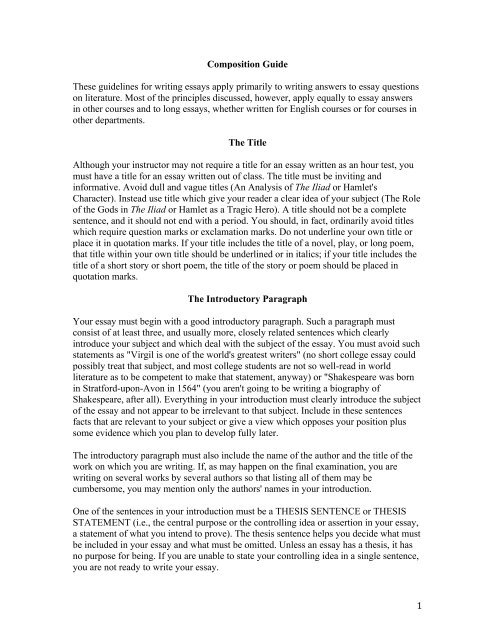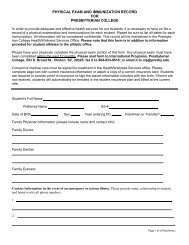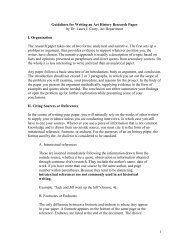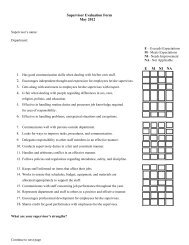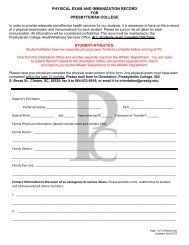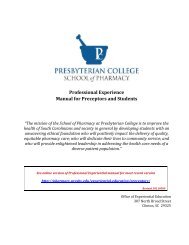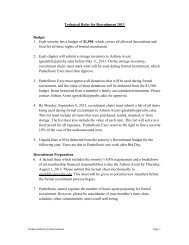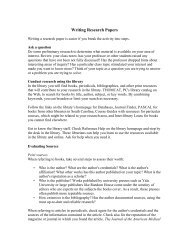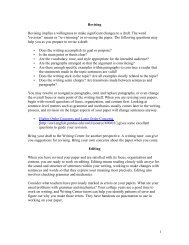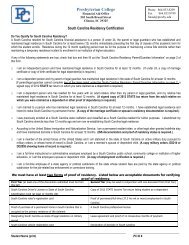Composition Guide - Presbyterian College
Composition Guide - Presbyterian College
Composition Guide - Presbyterian College
Create successful ePaper yourself
Turn your PDF publications into a flip-book with our unique Google optimized e-Paper software.
<strong>Composition</strong> <strong>Guide</strong><br />
These guidelines for writing essays apply primarily to writing answers to essay questions<br />
on literature. Most of the principles discussed, however, apply equally to essay answers<br />
in other courses and to long essays, whether written for English courses or for courses in<br />
other departments.<br />
The Title<br />
Although your instructor may not require a title for an essay written as an hour test, you<br />
must have a title for an essay written out of class. The title must be inviting and<br />
informative. Avoid dull and vague titles (An Analysis of The Iliad or Hamlet's<br />
Character). Instead use title which give your reader a clear idea of your subject (The Role<br />
of the Gods in The Iliad or Hamlet as a Tragic Hero). A title should not be a complete<br />
sentence, and it should not end with a period. You should, in fact, ordinarily avoid titles<br />
which require question marks or exclamation marks. Do not underline your own title or<br />
place it in quotation marks. If your title includes the title of a novel, play, or long poem,<br />
that title within your own title should be underlined or in italics; if your title includes the<br />
title of a short story or short poem, the title of the story or poem should be placed in<br />
quotation marks.<br />
The Introductory Paragraph<br />
Your essay must begin with a good introductory paragraph. Such a paragraph must<br />
consist of at least three, and usually more, closely related sentences which clearly<br />
introduce your subject and which deal with the subject of the essay. You must avoid such<br />
statements as "Virgil is one of the world's greatest writers" (no short college essay could<br />
possibly treat that subject, and most college students are not so well-read in world<br />
literature as to be competent to make that statement, anyway) or "Shakespeare was born<br />
in Stratford-upon-Avon in 1564" (you aren't going to be writing a biography of<br />
Shakespeare, after all). Everything in your introduction must clearly introduce the subject<br />
of the essay and not appear to be irrelevant to that subject. Include in these sentences<br />
facts that are relevant to your subject or give a view which opposes your position plus<br />
some evidence which you plan to develop fully later.<br />
The introductory paragraph must also include the name of the author and the title of the<br />
work on which you are writing. If, as may happen on the final examination, you are<br />
writing on several works by several authors so that listing all of them may be<br />
cumbersome, you may mention only the authors' names in your introduction.<br />
One of the sentences in your introduction must be a THESIS SENTENCE or THESIS<br />
STATEMENT (i.e., the central purpose or the controlling idea or assertion in your essay,<br />
a statement of what you intend to prove). The thesis sentence helps you decide what must<br />
be included in your essay and what must be omitted. Unless an essay has a thesis, it has<br />
no purpose for being. If you are unable to state your controlling idea in a single sentence,<br />
you are not ready to write your essay.<br />
<br />
1
The thesis statement is not an announcement that you are going to say something ("I am<br />
going to write on the character of Odysseus in The Odyssey"). Nor is it a vague assertion<br />
about a broad topic ("In his adventures Odysseus displays several important virtues").<br />
The problem in this last example is that the reader is not told what specific virtues you<br />
have in mind. Your thesis must be a concrete statement in which you set forth an<br />
assertion in a single, uncomplicated sentence ("Homer characterizes Odysseus as the<br />
ideal Greek king"). Since most essays are written to support your opinion, it might be<br />
helpful to think of the thesis as an arguable statement–one that someone may take<br />
exception to or argue about. At the very least, the thesis must make a point that calls for<br />
support.<br />
Finally, the introductory paragraph must indicate the order of your argument to show how<br />
and in what order you will present evidence to support your thesis. If the purpose of the<br />
essay is to prove that Odysseus is a heroic figure, the thesis should simply read,<br />
"Odysseus is clearly a heroic figure." In another sentence you need to indicate the kinds<br />
of evidence you intend to cite and the order in which that evidence is to be presented<br />
(e.g., "Odysseus's heroic qualities include courage, cunning, and loyalty to family"). If<br />
your subject is an especially complicated one, you may not be able to indicate the order<br />
in a single sentence, and you should not try to do so if that sentence becomes unduly<br />
complicated. In such cases you should feel free to indicate the order of your essay in<br />
several sentences.<br />
In any case, readers of your essay must know by the time they finish reading your<br />
introductory paragraph (1) the author and the title of the work on which you are writing,<br />
(2) your thesis statement–i.e., the point that you are making, and (3) the way in which<br />
you are going to organize the body of your essay. An introduction which does not make<br />
these matters clear is inadequate.<br />
Study the sample introductory paragraph below and the analysis of the introduction<br />
which follows it.<br />
Modern readers are often disturbed by the self-centeredness of Achilles, the hero<br />
of Homer's The Iliad. Achilles not only withdraws from battle and refuses to<br />
support his Greek comrades because of injured pride, but he even hopes that the<br />
Trojan enemies will defeat his fellow Greeks. Nevertheless, Homer means for us<br />
to see Achilles as an admirable, heroic figure. Homer clearly saw him as the<br />
greatest of the warriors at Troy because Achilles has the quality of excellence that<br />
was sought after by all Mycenean heroes. To Homer this quality, commonly<br />
known as arete, included excellence in all the ways a man could be excellent:<br />
physical excellence, moral excellence, and intellectual excellence.<br />
This paragraph contains all of the elements which a good introduction must have. It<br />
includes the name of the author and the title of the work on which the essay is being<br />
written (Homer's The Iliad.) The five sentences in the introduction are clearly related.<br />
The first notes that modern readers may not find Achilles to be very heroic (a position<br />
which the essay itself will seek the refute). The second sentence gives some evidence to<br />
<br />
2
support the modern view that Achilles is not very heroic. The next sentence, introduced<br />
by that important word nevertheless, states the thesis–that despite what we moderns may<br />
think, Homer intends for his readers to regard Achilles as a hero. The next sentence<br />
explains briefly why Homer regarded Achilles as a hero–he possesses qualities of<br />
excellence admired by Homer and his contemporaries. The final sentence is more specific<br />
in listing the categories of excellence which the ancient Greeks prized, and the sentence<br />
indicates the order in which these categories will be taken up in the body of the essay.<br />
Based on the final sentence of the paragraph, the reader can expect to find one paragraph<br />
which will deal with physical excellence, a second on moral excellence, and a final<br />
paragraph on intellectual excellence.<br />
The Body of the Essay<br />
The introductory paragraph will be followed by developmental paragraphs which make<br />
up the body of the essay. Many essay questions which you will be asked to answer lend<br />
themselves to organization in three parts. In the sample introductory paragraph above, the<br />
writer clearly intends to divide the body of the essay into three parts. Sometimes on hour<br />
tests you may be given a subject which can best be divided into two developmental<br />
paragraphs; sometimes you may prefer to organize in four or, especially on a final<br />
examination, more than four paragraphs.<br />
Each developmental paragraph must include a topic sentence, which is often the first<br />
sentence in the paragraph. The topic sentence is to the paragraph what the thesis sentence<br />
is to the essay as a whole–it is the controlling idea that determines what can be placed in<br />
a paragraph and what cannot be placed in the paragraph. The topic sentence must be a<br />
generalization, never a narrative detail. If you were writing on Odysseus as an ideal<br />
Greek hero, your plan might be to emphasize such admirable qualities as Odysseus'<br />
courage, his physical strength, and his devotion to his country. Your topic sentence for<br />
the first developmental paragraph might read, "Examples of Odysseus' courage are found<br />
in nearly every book in which Odysseus appears." The rest of your paragraph would cite<br />
specific examples of his courage. You would not include in that paragraph examples of<br />
his strength or of his devotion to his country. To do so would be to violate the concept of<br />
unity.<br />
Unity is achieved when a writer develops the topic sentence and does not deviate from it.<br />
If you digress, you merely confuse your reader. The topic sentence can help you maintain<br />
unity if you keep asking yourself if the example you are citing really is an example of<br />
your topic sentence.<br />
Problems with unity sometimes come about when the writer summarizes the plot of a<br />
work excessively. Remember that an essay on literature is not a plot summary! You must<br />
be able to summarize mentally the plot of a work so that you can draw illustrations from<br />
your mental summary. You must not include in your essay details of plot summary which<br />
merely lead up to an example but which do not themselves include an example. Study the<br />
very poor paragraph below. The first sentence, which has been underlined, is the topic<br />
sentence.<br />
<br />
3
Orgon's interest in Tartuffe is obviously excessive because it prevents Orgon from<br />
taking an interest in anyone else. Upon returning home after a brief absence,<br />
Orgon inquires into the health of the members of his household. Dorine, the maid,<br />
reports that Orgon's wife, Elmire, has been ill, and she describes the symptoms of<br />
Elmire's illness. But Orgon takes no interest in his wife's condition and interrupts<br />
Dorine to ask about Tartuffe. Each time Dorine mentions Elmire's health, Orgon<br />
interrupts to ask about Tartuffe. It is obvious that Orgon's interest in Tartuffe is<br />
excessive because it prevents him from taking as interest in the health of his wife.<br />
There are at least three problems with the paragraph. First of all, the first two sentences<br />
which follow the topic sentence do not illustrate the topic sentence but merely lead up the<br />
third sentence, which does illustrate the topic sentence. If fact, the first sentence<br />
following the topic sentence seems to contradict the topic sentence. The two sentences<br />
provide too much plot summary and--because they do not directly illustrate the topic--<br />
violate the principles of unity; they are digressions. The two sentences which follow the<br />
topic sentence should have been subordinated and made a part of the third sentence.<br />
Second, the paragraph lacks adequate substance. The illustration is limited to a single<br />
incident, and it is not treated vividly and fully. Finally, the last sentence of the paragraph<br />
repeats the topic sentence. Remember that a paragraph should contain one generalization<br />
(which must be stated in the topic sentence) and it must not be repeated. Every sentence<br />
which follows the topic sentence must develop the topic sentence. You can easily test the<br />
unity of your paragraph by looking critically at every sentence to see if each one does<br />
indeed illustrate the topic sentence. Study the revised version below of the paragraph on<br />
Tartuffe.<br />
Orgon's interest in Tartuffe is obviously excessive because it prevents Orgon from<br />
taking an interest in anyone else. When, upon returning home after a brief<br />
absence, Orgon inquires into the health of the members of his household and<br />
learns from the maid, Dorine, that Orgon's wife, Elmire, has been ill, Orgon<br />
interrupts to ask about Tartuffe. When Dorine goes on to report that Elmire's<br />
headache was so severe that Elmire could not eat her dinner, Orgon again<br />
interrupts to ask, "And Tartuffe?" Even when Dorine explains that Elmire had to<br />
undergo bloodletting to cure her headache, Orgon shows no concern and again<br />
inquires about Tartuffe's health. Orgon later shows the same indifference toward<br />
his daughter, Mariane, when he insists that she break off her engagement to<br />
Valere, the man whom she loves, and marry Tartuffe instead. Finally, Orgon<br />
shows his excessive admiration for Tartuffe when, upon becoming angry with his<br />
son, Damis, Orgon disinherits Damis and names Tartuffe as his heir.<br />
In the revision above, every sentence illustrates the topic sentence. Moreover, while one<br />
incident is treated in some detail in three sentences, the two other examples from other<br />
scenes in the play are briefly cited to show that the point made in the topic sentence is not<br />
limited to an isolated situation. Note, too, that the paragraph illustrates proportion in that<br />
the best example–the scenes dealing with Orgon's return home–is treated in some detail<br />
while the other two scenes are treated in a single sentence each. Go back now and read<br />
<br />
4
the revision again, noting how every sentence that follows the topic sentence contains an<br />
example of the point that the topic sentence makes. The paragraph is well unified.<br />
Be careful to avoid the temptation to use the work on which you are writing as the means<br />
to moralize. An interpretation of a work of literature should deal with the work and what<br />
the author of the work is seeking to do. If you include your own moral, political, or social<br />
views, you violate the unity of the paragraph just as surely as you would if you<br />
summarize parts of the plot which have no bearing on the topic sentence.<br />
Substance<br />
A good developmental paragraph must have ample substance. Substance consists of the<br />
specific examples from the work which you cite in support of your thesis sentence and of<br />
the topic sentence of each paragraph. The revised version of the paragraph on Tartuffe<br />
has sufficient substance to prove the point made in the topic sentence. There are, in fact,<br />
five specific examples of Orgon's indifference to the members of his family because of<br />
his excessive interest in Tartuffe. Never have fewer than two very good examples in a<br />
paragraph; usually you will need to have more than two examples in order to persuade<br />
your reader that the assertions made in your thesis statement and in your topic sentence<br />
are accurate and can be supported by persuasive evidence. If you cite but one example or<br />
two weak ones, the reader will not be persuaded.<br />
Good substance depends on more than the number of examples you cite. Your examples<br />
must be fully developed so that your paragraph won't read like a list or an outline.<br />
Remember your readers. You should assume that they have read the work on which you<br />
are writing, but you should not assume that they have read the work recently. It is<br />
important, therefore, to develop your examples with enough detail so that your readers<br />
can recall them. You should also include enough of the context so that readers can<br />
remember roughly where the incident or speech to which you are referring occurs.<br />
Quoting a key word, phrase, or larger element is an effective way to achieve good<br />
substance.<br />
Read the paragraph below. It illustrates what too often happens when substance is not<br />
fully developed.<br />
Zeus' anthropomorphic nature is clearly seen on those occasions when Zeus<br />
threatens physical violence to those who oppose him. At one point Zeus angrily<br />
tells Hera that she can do nothing about his pledge to help Achilles and that the<br />
other gods on Mt. Olympus are not strong enough to save her from his violence.<br />
Later Hera is again threatened when Zeus realizes that Hector has been wounded<br />
because of Hera. Zeus's most violent threat is made to any god or goddess who<br />
might consider opposing him by interfering in the course of the war. Such an<br />
offender, he says, will be severely punished.<br />
The paragraph has a clear topic sentence and three examples. But the examples are not<br />
developed fully enough for someone who has not read The Iliad recently to be able to<br />
remember the scenes described or to remember the context in which the threats were<br />
<br />
5
made. The first example is introduced with the phrase "At one point." That phrase is too<br />
vague. Actually, the example is taken from the first book of The Iliad; it would be better<br />
to write, "In Book I, Zeus angrily tells Hera. . . ." If you cannot remember which book (or<br />
chapter in a novel or act of a play) your example comes from, at least give some details<br />
about the context to help your reader recall the scene. The second example ("Later Hera<br />
is again threatened when Zeus realizes that Hector has been wounded because of Hera")<br />
hardly counts as an example at all. We are not told with what violence she is threatened,<br />
and we don't really understand why Hera is responsible for Hector's death. The reader of<br />
your paper will naturally want to be reminded with what Hera is being threatened and<br />
why she should be punished. It is the responsibility of the writer to provide answers to<br />
such questions. The final example ("Zeus's most violent threat . . .") provides neither the<br />
context in which the threat is ordered (a truce has been arranged between the Greeks and<br />
Trojans) nor an explanation for what the writer of the paper means by "severely<br />
punished." Be specific. Be concrete. Remember that to be persuasive, you must make<br />
clear to your reader that you know the details of the work. Don't just tell your readers<br />
something; show them what you mean with specific, concrete examples, details, and<br />
explanations.<br />
The paragraph below is a revision of the paragraph above. Study it carefully and notice<br />
how it conveys much more information to the reader.<br />
Zeus's anthropomorphic nature is clearly seen on those occasions when Zeus<br />
threatens violence to those who oppose him. When near the beginning of the epic<br />
Hera learns that Zeus has promised Thetis that he will help Achilles and chides<br />
Zeus for his promise, Zeus angrily tells Hera that all the gods on Mt. Olympus<br />
will not be strong enough to save her from his wrath if she interferes with his will.<br />
She is again threatened with his violence when Zeus discovers that, despite his<br />
earlier warning, Hera has continued to interfere with in the war and that Hector<br />
has been wounded because Hera diverted Zeus's attention. Calling her<br />
"mischiefmaker," Zeus reminds Hera how he punished her on an earlier occasion<br />
for disobeying him by hanging her by gold chains in the clouds with anvils<br />
fastened to her feet, and he threatens to thrash her if she continues to oppose him.<br />
Zeus's most violent threat is made during a truce between the Greeks and Trojans.<br />
That threat is addressed not only to Hera but also to any god or goddess who even<br />
considers interfering in the course of the war: He promises to beat such offenders<br />
severely or to hurl them into Hades.<br />
The revised paragraph solves the more serious problems found in the original. Following<br />
the topic sentence, the writer introduces the first example by telling us something fairly<br />
specific about where that example comes from ("near the beginning of the epic"). That<br />
phrase is certainly more helpful than the "At one point" of the original draft. And the<br />
example itself is fuller; we are told that Zeus uttered his threat because Hera was angry<br />
because of his promise to help Thetis' son, Achilles. The second example is introduced<br />
with a reminder of the context in which Zeus's threat is made: Zeus has discovered that<br />
Hera, ignoring his warning not to interfere, has diverted his attention with the result that<br />
Hector has been wounded. Zeus's violent nature is made even more vivid by Zeus's<br />
<br />
6
eminder of an earlier event in which he had punished Hera by hanging her in the clouds<br />
with anvils tied to her feet and by his latest threat to thrash her unless she stops<br />
interfering with the war. Compare the original ("Later Hera is again threatened when<br />
Zeus realizes that Hector has been wounded because of Hera") with the revision. The<br />
revision is obviously more detailed and informative. The revision is an example of good<br />
substance. The final example in the revision, too, is much more specific than the original.<br />
In the original version, the reader is told only that offenders "will be severely punished."<br />
In the revision, we are told that they will be punished by a severe beating or by being sent<br />
to Hades.<br />
Organizing the Developmental Paragraphs<br />
Organization means orderly arrangement. In a well-organized paragraph the details used<br />
to substantiate the topic sentence are presented in an orderly sequence of sentences. The<br />
arrangement of sentences will largely depend upon the type of composition you are<br />
writing.<br />
Generally speaking, there are two kinds of order that may be used in the paragraph:<br />
Natural Order and Logical Order. If you arrange your sentences in natural order, you are<br />
following an order that seems to you to be inherent in the subject about which you are<br />
writing. Paragraphs of description and narration often follow natural order. Writers of<br />
descriptive paragraphs, for example, may present details seen from left to right or from<br />
top to bottom. Writers of narrative paragraphs frequently present details in the order of<br />
their occurrence; that is, they will use chronological order. Logical order is order which is<br />
determined by the writer's analysis of the subject. Such order is determined by the writer's<br />
reason. The writer must consciously will it, even force it upon the subject. It is not based<br />
on an order (either spatial or chronological) that seems inherent in the subject.<br />
Examine the paragraph on Zeus's anthropomorphic nature. Notice that the arrangement<br />
here is logical. The writer has violated chronological order in so as to be able to place<br />
what seems to be the strongest bit of supporting evidence in the post prominent place in<br />
the paragraph--the final sentence. That evidence (that Zeus threatens not only Hera but<br />
also all the gods and goddesses) actually comes in Book Eight of The Iliad, long before<br />
the threat made in Book Fifteen, which is used as the second example. The writer has<br />
wisely cited the most effective example last. To have placed it earlier would have made<br />
any examples which followed it seem anticlimactic. In the case of the revised paragraph<br />
on Tartuffe earlier, chronological order was used because the first example cited--Orgon's<br />
return from a trip--deals with Orgon's first appearance in the play. That example<br />
establishes Orgon's blind devotion to Tartuffe from the first time the audience sees<br />
Orgon. Notice that in the model on Zeus's anthropomorphic nature there is movement<br />
from the general to the specific. The topic sentence, which is a generalization about one<br />
aspect of Zeus's anthropomorphic nature, is followed by three references to specific<br />
examples of Zeus's threats of violence in The Iliad.<br />
<br />
7
Organizing the Essay<br />
Just as the individual paragraphs which make up an essay must be carefully organized to<br />
be persuasive, so, too, does the essay itself have to be organized in order to be coherent<br />
and persuasive. You need to keep your thesis sentence in mind throughout and to<br />
remember to select details from the plot to support that thesis but not to include anything<br />
which does not directly support the thesis. You need to think about all of the evidence<br />
which supports the thesis and to organize that evidence into logical categories. The<br />
categories will form the individual developmental paragraphs. These categories should be<br />
made clear to the reader in the introductory paragraph, and they will form the basis of the<br />
topic sentences in the developmental paragraphs.<br />
The outline below should help you understand the principles of organizing an essay.<br />
Title<br />
Introductory paragraph<br />
Body of the Essay (three or more<br />
paragraphs of documentation as<br />
needed)<br />
Includes<br />
1. name of author and title of work being written on<br />
[when several works are involved, instructor may not<br />
require all authors and titles]<br />
2. thesis statement<br />
3. two, three, or more ideas or categories which will<br />
develop the thesis in the body paragraphs<br />
Topic sentence about one of the ideas or categories<br />
mentioned in the introductory paragraph.<br />
1. specific detail (speech or action that supports the<br />
point)<br />
2. specific detail (speech or action that supports the<br />
point)<br />
3. specific detail (speech or action that supports the<br />
point)<br />
4. continue with details as needed<br />
Remember that the number of developmental paragraphs in your essay will depend on the<br />
way in which you organize your material. Frequently the essay question will lend itself to<br />
organizing into a four-paragraph essay (introductory paragraph plus three developmental<br />
paragraphs); sometimes the most logical method will result in a three-paragraph essay<br />
(introductory paragraph plus two very full developmental paragraphs). Consult your<br />
professor about a concluding paragraph.<br />
Special Problems Regarding the Organization of an Essay<br />
The organization of an essay should not pose any particular problems when you are<br />
writing on such subjects as the anthropomorphic nature of Zeus, the qualities of an ideal<br />
hero such as Achilles, or any other subject about a single figure. A problem may occur<br />
when you write about more than one character or when you are writing about more than<br />
one work, such as occurs if you are required to compare two or more characters or works<br />
<br />
8
or to contrast several figures or works. You may be tempted to devote a single paragraph<br />
to one figure, a second to another, and a third to still another; or, if you are writing an<br />
essay on more than one work, you may be tempted to treat one work in one paragraph<br />
and to treat another work in another paragraph. Such paragraphs rarely exhibit coherence.<br />
All you do is to write what you have to say about one character (or work) before you<br />
move on to write what you have to say about another character (or work). Although a<br />
skilled writer, using enough transitions and references, may be successful in treating<br />
figures or works separately, most writers fail because they lose the thread that should be<br />
tying their analyses of characters or works together.<br />
If you are called upon to deal with several characters or works in an essay, you should<br />
find topics which will allow you to deal with several characters or works in the same<br />
paragraph. If, for example, you were writing an essay comparing villains in Shakespeare's<br />
plays, you would first need to decide which villains you want to treat; you would then<br />
need to decide what three or four qualities these villains have in common, and you would<br />
use each quality as the basis for a topic sentence. In each paragraph, then, you would deal<br />
with a particular quality and then treat each of the villains in such a way as to show how<br />
each demonstrates that quality. Finally, you would have to think carefully about your<br />
material in order to devise some logical pattern of development that would give the essay<br />
coherence.<br />
Let us say, for example, that you have decided to write on such Shakespearean villains as<br />
King Richard in Richard III, Edmund in King Lear, and Iago in Othello. You would first<br />
have to consider what these characters do and say in their respective plays in order to<br />
determine what attitudes or qualities you see that these three have in common. You<br />
would certainly notice that all three sense that they have been wronged, either by<br />
circumstances beyond their control or by other people You might then begin a<br />
developmental paragraph with the following topic sentence: "Each of the three believes<br />
that he has been injured, either by nature or by some individual." In the sentences that<br />
follow, you would then cite and develop such examples as King Richard's physical<br />
deformity, Edmund's illegitimacy, and Iago's being unfairly passed over for promotion in<br />
Othello's army.<br />
You might then move on to note that these three villains are extremely ambitious. You<br />
might, therefore, begin another developmental paragraph by writing, "All three figures<br />
are ambitious to improve their positions in society." The sentences that follow that topic<br />
sentence would explain what each figure seeks to achieve. You might then go on to<br />
notice that none of these characters have any scruples at all about hurting others, and you<br />
might then begin your next developmental paragraph by writing, "In their attempts to<br />
achieve their goals, the three villains make clear that they are altogether unconcerned<br />
about the suffering they may cause others." That paragraph should illustrate how each<br />
character is indifferent to those whom he injures.<br />
You would no doubt develop and emphasize throughout your essay a logical pattern of<br />
coherence: (1) their villainy begins within themselves with a belief that each is in some<br />
way a victim; (2) because of this belief, they feel a need to prove themselves superior to<br />
<br />
9
others; and finally (3) they are so committed to proving themselves that they are<br />
indifferent to the harm they do to others. Some of the best writers make such patterns of<br />
coherence clear in their introductory paragraphs.<br />
Transition<br />
A paragraph may have substance and unity and still not be completely effective if<br />
transition within the paragraph and transitions between paragraphs are not properly<br />
handled. Transition means passing over from one stage of development to another.<br />
Transition involves logical movement and development within the paragraph and from<br />
one paragraph to another. This movement and development are effective when sentences<br />
lead naturally from one to another and when each sentence refers naturally to the<br />
preceding one.<br />
Often the close connection of thought in a paragraph will ensure proper transition. But<br />
the writer must often use transitional devices in order to obtain effective transitions. In<br />
the revised paragraph about the anthropomorphic nature of Zeus, smooth transition has<br />
been achieved by repetition. The topic sentence announces that the subject of the<br />
paragraph is Zeus's violent nature and his tendency to make angry threats. The second<br />
sentence contains the words "Zeus angrily tells Hera that all the gods on<br />
Mt. Olympus will not be strong enough to save her from his wrath. . . ." The next<br />
sentence begins, "She is again threatened with violence. . . ." The final example, which is<br />
treated in the last two sentences of the paragraph, begins, "Zeus's most violent threat. . . ."<br />
Repetition of key words or phrases can be a very effective device. However, if overused,<br />
repetition will become monotonous. When you repeat ideas, try to express them in<br />
different words.<br />
Frequently words which have antecedents in preceding sentences or clauses can be used<br />
effectively as transitional devices. These words may be personal or demonstrative<br />
pronouns or adjectives that refer to nouns in preceding sentences or clauses. The words<br />
this, that, these, and those are the demonstratives that may be used as either adjectives or<br />
pronouns. The writer should be careful in using these words as pronouns. Each<br />
demonstrative pronoun must have a single word as its antecedent and should never refer<br />
vaguely to an action or an idea in a preceding sentence or clause.<br />
There are several other expressions that can be used as transitional devices. These<br />
expressions may be either words or phrases that call attention to a relationship between<br />
the details in two or more sentences or which introduce another example within a<br />
paragraph. Some words that are frequently used as transitional devices include also,<br />
accordingly, afterwards, again, besides, consequently, furthermore, hence, however,<br />
indeed, moreover, nevertheless, next, otherwise, still, and therefore. Phrases used as<br />
transitions include as a result, at the same time, for instance, generally speaking, in<br />
addition to, and on the other hand. Be extremely careful about using transitional devices.<br />
Transitions should be natural and should never appear to be artificial. If you see a clear<br />
relationship between details and if you are writing effective sentences, you will probably<br />
achieve transition without making a conscious effort.<br />
<br />
10
Style<br />
In addition to substance, unity, organization, and transitions, a paragraph or essay must<br />
be written in an effective style. Style is the manner in which ideas are expressed. Style<br />
includes such matters as diction (i.e., word choice), syntax, and sentence variety. Words<br />
should be chosen for their exactness; the sentences should be written in a natural,<br />
unaffected syntax (word order); there should be a balance of sentence types (simple,<br />
compound, complex, and compound-complex). The best of ideas can be spoiled by<br />
inappropriate word choice, by artificial syntax, or by a series of simple sentences. You<br />
should train yourself to hear the sentences which you are writing mentally and to ask<br />
yourself how they would sound if they were read aloud. Avoid sentences that are<br />
awkward, wordy, ambiguous, pretentious, or artificial.<br />
Writing that is done for college tests and papers is relatively formal. Therefore, you<br />
should avoid addressing the reader directly ("You can clearly see that Homer is a master<br />
in describing the horrors of war"), and you must avoid colloquialisms, slang, and jargon.<br />
Your writing should show that you have a good vocabulary and that you know how to use<br />
language gracefully and effectively. Good writing does not try to impress; rather, it seeks<br />
to communicate clearly. While it has some degree of sophistication, it is never pompous.<br />
The style should be that of a college-level student and not that of an eighth grader. The<br />
reader should sense that every word belongs in the paper--that each word contributes to<br />
the development of the central idea. The choice and arrangement of words should always<br />
reflect the writer's maturity in handling the language.<br />
Evaluation of the Essay<br />
As soon as is humanly possible after you have turned in an essay or essay test, your<br />
instructor will read it several times, mark it, put a grade on it, and return it to you to see.<br />
The process may be painful to you, especially if you are unaccustomed to having your<br />
writing evaluated by college standards. Please accept the comments of your instructor as<br />
constructive criticism which is intended to help you do better in the future. Hard work<br />
and practice on your part and on the part of your instructor should lead to results of which<br />
you both will be proud.<br />
Take notes on the matters that gave you problems and review them before the next test or<br />
essay so that you can benefit from the previous comments of your instructor. If after<br />
noting the comments on your paper, you still don't understand what you need to do to<br />
improve, see your instructor as soon as possible. The English faculty members assume<br />
that college students who are serious about wanting to do good work are mature enough<br />
to seek our help. We want to help all students do the best work they are capable of doing,<br />
but we assume that students who sincerely want to learn will take the initiative to get<br />
help. We also assume that students will use conference time with instructors<br />
constructively. We are not particularly interested in knowing how much better you did in<br />
high school writing classes; you are now being judged by college standards which are<br />
naturally more demanding than the standards of most high schools. And if you had a bad<br />
<br />
11
ackground in English in your high school, complaining about that background won't<br />
help you overcome your weaknesses. Dwelling on the past or making excuses will only<br />
sap your energy and rob you of the time you need to improve. You have a chance to learn<br />
good writing habits now. Forget about the past!<br />
From the <strong>Presbyterian</strong> <strong>College</strong> Handbook of Grammar and Usage, third edition, 1991,<br />
68-83. S. Allen King wrote the first edition in 1984. Members of the <strong>Presbyterian</strong> <strong>College</strong><br />
English Department revised it in1991.<br />
<br />
12


